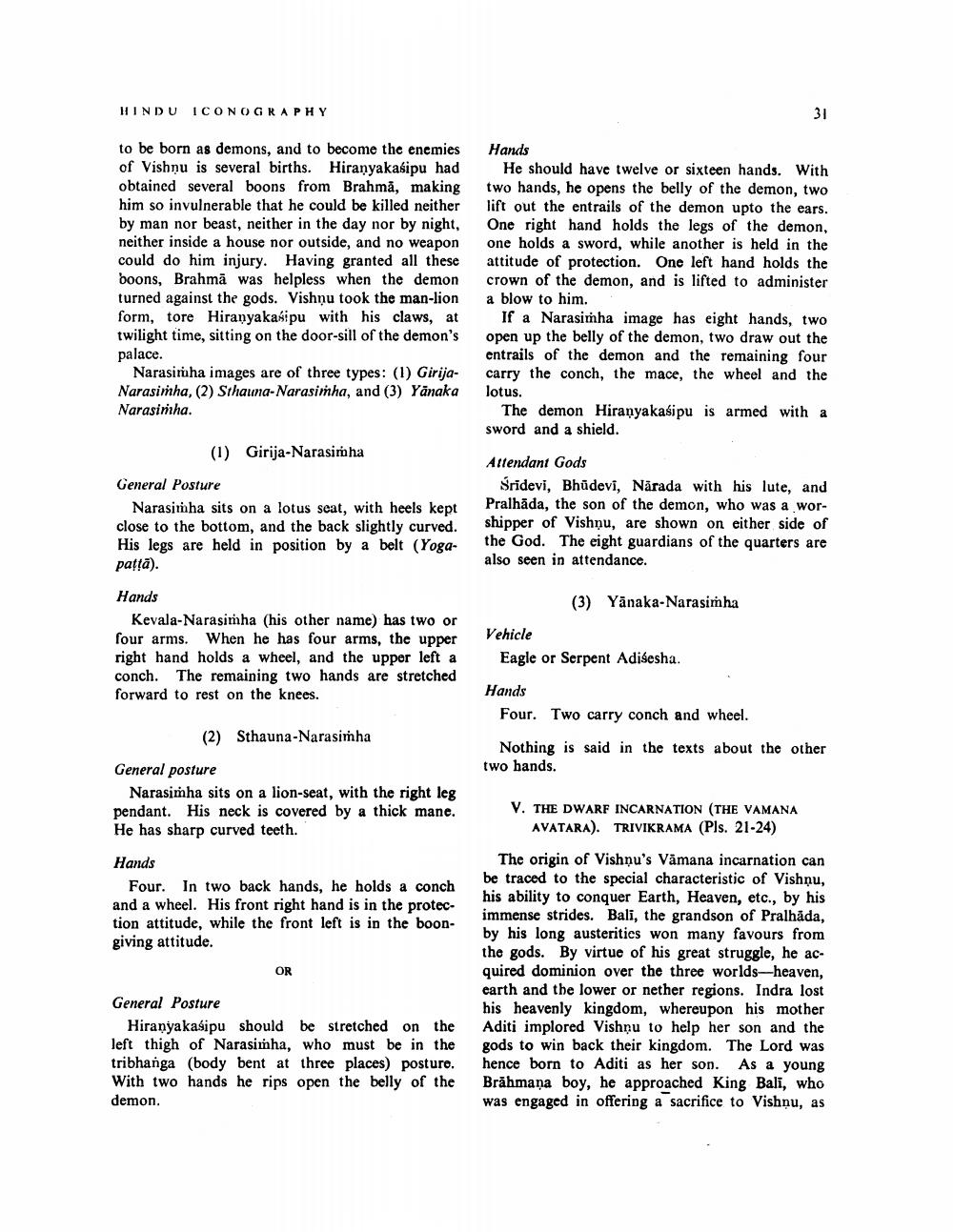________________
HINDU ICONOGRAPHY
to be born as demons, and to become the enemies of Vishnu is several births. Hiranyakasipu had obtained several boons from Brahma, making him so invulnerable that he could be killed neither by man nor beast, neither in the day nor by night, neither inside a house nor outside, and no weapon could do him injury. Having granted all these boons, Brahma was helpless when the demon turned against the gods. Vishnu took the man-lion form, tore Hiranyakasipu with his claws, at twilight time, sitting on the door-sill of the demon's palace.
Narasimha images are of three types: (1) GirijaNarasimha, (2) Sthauna-Narasimha, and (3) Yanaka Narasimha.
(1) Girija-Narasimha
General Posture
Narasimha sits on a lotus seat, with heels kept close to the bottom, and the back slightly curved. His legs are held in position by a belt (Yogapaṭṭā).
Hands
Kevala-Narasimha (his other name) has two or four arms. When he has four arms, the upper right hand holds a wheel, and the upper left a conch. The remaining two hands are stretched forward to rest on the knees.
(2) Sthauna-Narasimha
General posture
Narasimha sits on a lion-seat, with the right leg pendant. His neck is covered by a thick mane. He has sharp curved teeth.
Hands
Four. In two back hands, he holds a conch and a wheel. His front right hand is in the protection attitude, while the front left is in the boongiving attitude.
OR
General Posture
Hiranyakasipu should be stretched on the left thigh of Narasimha, who must be in the tribhanga (body bent at three places) posture. With two hands he rips open the belly of the demon.
Hands
He should have twelve or sixteen hands. With two hands, he opens the belly of the demon, two lift out the entrails of the demon upto the ears. One right hand holds the legs of the demon, one holds a sword, while another is held in the attitude of protection. One left hand holds the crown of the demon, and is lifted to administer a blow to him.
If a Narasimha image has eight hands, two open up the belly of the demon, two draw out the entrails of the demon and the remaining four carry the conch, the mace, the wheel and the lotus.
The demon Hiranyakasipu is armed with a sword and a shield.
31
Attendant Gods
Śridevi, Bhudevi, Narada with his lute, and Pralhada, the son of the demon, who was a worshipper of Vishnu, are shown on either side of the God. The eight guardians of the quarters are also seen in attendance.
(3) Yanaka-Narasimha
Vehicle
Eagle or Serpent Adisesha.
Hands
Four. Two carry conch and wheel.
Nothing is said in the texts about the other two hands.
V. THE DWARF INCARNATION (THE VAMANA AVATARA). TRIVIKRAMA (Pls. 21-24)
The origin of Vishnu's Vamana incarnation can be traced to the special characteristic of Vishnu, his ability to conquer Earth, Heaven, etc., by his immense strides. Bali, the grandson of Pralhäda, by his long austerities won many favours from the gods. By virtue of his great struggle, he acquired dominion over the three worlds-heaven, earth and the lower or nether regions. Indra lost his heavenly kingdom, whereupon his mother Aditi implored Vishnu to help her son and the gods to win back their kingdom. The Lord was hence born to Aditi as her son. As a young Brāhmaṇa boy, he approached King Bali, who was engaged in offering a sacrifice to Vishnu, as




